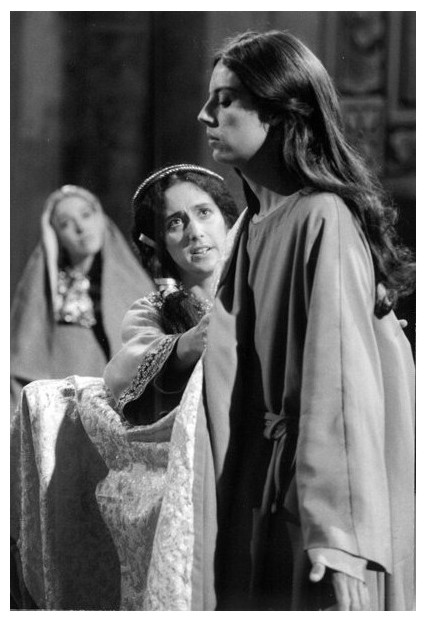
bernard d. sherman. inside early music, conversations with performers
Chapter 3. Vox Feminae, Barbara Thornton on Hildegard of Bingen
notes

1. The essay, "The Visions of Hildegard", is reprinted in Sacks, The
Man Who Mistook His Wife for a Hat (New York: Summit Books, 1986),
pp. 166-70.
2. Ibid., p. 130; the comment comes from Sacks's introduction
to the section of the book that contains the Hildegard essay, and
applies not only to Hildegard but to others discussed in the section.
3. Mary Berry, Gramophone (May 1995), p. 94
4. Thornton, "Vox Feminae: The Ecstatic Devotions of Hildegard
von Bingen," (program notes, 1993), p. 3.
5. For more thorough discussion, see the relevant chapters in Norman
Cantor's introductory history, The Civilization of the Middle Ages
(New York: Harper Collins, 1993), notably pp. 306-56. To quote another
writer, A. C. Crombie, it was in the twelfth century that "men of
philosophic temperament began to turn away from the vision, given them
by St. Augustine, of the natural world as a symbol of another,
spiritual world, and to see it as a world of natural causes open to
investigation by observation and hypothesis". In Crombie, Science,
Optics, and Music in Medieval and Early Modern Thought (London:
Hambledon Press, 1990), quoted in Christopher Page's Discarding
Images (Oxford University Press, 1993), p. 11.
6. See Christopher Brooke's The Twelfth-Century Renaissance
(New York: Harcourt, Brace and World, 1970); Renaissance and
Renewal in the Twelfth Century, ed. R. L. Benson and G. Constable
(Oxford University Press, 1982); and Dom Jean LeClerq's The Love of
Learning and the Desire for God, 3rd ed., trans. C. Misrahi (New
York: Fordham University Press, 1982) on monastic life in the period.
Finally, the "dark underside" of the twelfth-century renaissance, the
increased persecution of groups such as the Jews, is discussed in R. I.
Moore's The Formation of a Persecuting Society (Oxford
University Press, 1987).
7. By Peter Dronke, Women Writers of the Middle Ages (Cambridge
University Press, 1984), P. 144. He also compares her to Goethe.
8. "Many wealthy people" buried family members at her convent. One such
burial, in 1178, was of a nobleman who had been excommunicated, though
in the end he was reconciled with the Church. The prelates of Mainz
alleged, however, that he had died
excommunicate, and they ordered Hildegard to remove his remains or be
excommunicated herself. She refused, and also defied (and challenged in
writing) their ban on music in her convent. Her nuns chose to remain
with her and thus be excommunicated as well. During this episode, the
Archbishop of Mainz was in Italy mediating between the Pope and the
Emperor Frederick Barbarossa; in 1179 the
Archbishop made it possible for the ban and excommunication to be
lifted. See Dronke, pp. 196-99.
9. Dronke, "Platonic-Christian Allegories in the Homilies of Hildegard
von Bingen", in From Athens to Chartres: Neo-Platonism and Medieval
Thought, Studies in Honor of Edouard Jeaneau, ed. J. H. Westra
(Leiden: E. J. Brill, 1992).
10. Carruthers, The Book of Memory (Cambridge University Press,
1991).
11. Leo Treitler cites the ethnomusicologist Robert Ridgely Labaree's
studies of troubadour songs, which suggest applying to plainchant ideas
developed in the study of Irish music. See section VII of Trekler's
"Sinners and Singers: A Morality Tale", Journal of the American
Musicological Society 47 (Fall 1994), pp. 137-71.
12. See Leo Treitler's work, for example "Centonate Chant", Journal
of the American Musicological Society 28 (1975), pp. 1-23. Treitler
differs with some predecessors who argue that chant composers put
together pre-existing formulas into an artistic whole; he says instead
that as all these chants were memorized, it was natural that certain
"well-defined moments in the progress of chants (openings, cadences,
continuations after cadences, settings of words with particular
syntactical functions such as conjunctions)" would tend to become
standardized within a genre of chant, and that what was in between
would be less fixed (I quote from "Sinners and Singers", p. 149).
Regarding oral cultures, see Walter Ong, Orality and Literacy
(London and New York: Methuen, 1982), chaps. 2 and 3.
13. The "perfect" intervals are the octave, the fourth, and the fifth;
all the rest are "imperfect."
14. See Harold Powers, "Mode", III, 1, in the New Grove Dictionary
of Music, vol. 12 (London: Macmillan, 1980), pp. 397-401.
15. See Christopher Page's interview, p. 80-81, for a more detailed
discussion of this.
16. See Page's interview for his views—very different from
Thornton's—on text expression in medieval music.
17. Ong, Orality and Literacy, p. 32. On p. 93 he discusses
this with reference to societies where writing is restricted to certain
sectors, as in Hildegard's time.
18. Symphoniae, Deutsche Harmonia Mundi (DHM) 77020-2—RG;
booklet, p. 9.
19. The piece is recorded on Sequentia's Symphoniae CD.
20. These two pieces are presented in succession on Sequentia's CD Canticles
of Ecstasy, DHM 05472-77320-2.
21. According to David Hiley, medievals knew the Timaeus in a
reworking by the fourth-century writer Calcidius; see Hiley's Western
Plainchant, pp. 443-44. The formulation of the three types of music
came into medieval thought from Boethius, the Roman statesman and
philosopher (c. 475-524), in his book De institutione musica.
22. Cantor, The Civilization of the Middle Ages, p. 356. He
argues that Hildegard's creations were "a form of women's revolt
against the male-dominated society. Confined and frustrated . . . she
single-handedly created an alternative culture in her imagination . . .
[in which] religious women have a special claim to articulate God's
word in the world".
23. Cantor, pp. 354-56.
24. See Dronke, Women Writers of the Middle Ages.
25. Porter, "Reanimations", The New Yorker, 22 October 1990, P.
100.
26. See, e.g., David Hiley's review in Early Music 13 (November
1985), p. 597, and Benjamin Bagby's essay, written in response,
"Musicology and Make-Believe?" Early Music 14 (November 1986),
p. 557.
27. Weber, Fanfare 19 (May/June 1996), pp. 167-68.
28. Moody, Early Music 21 (August 1993), p. 491.
